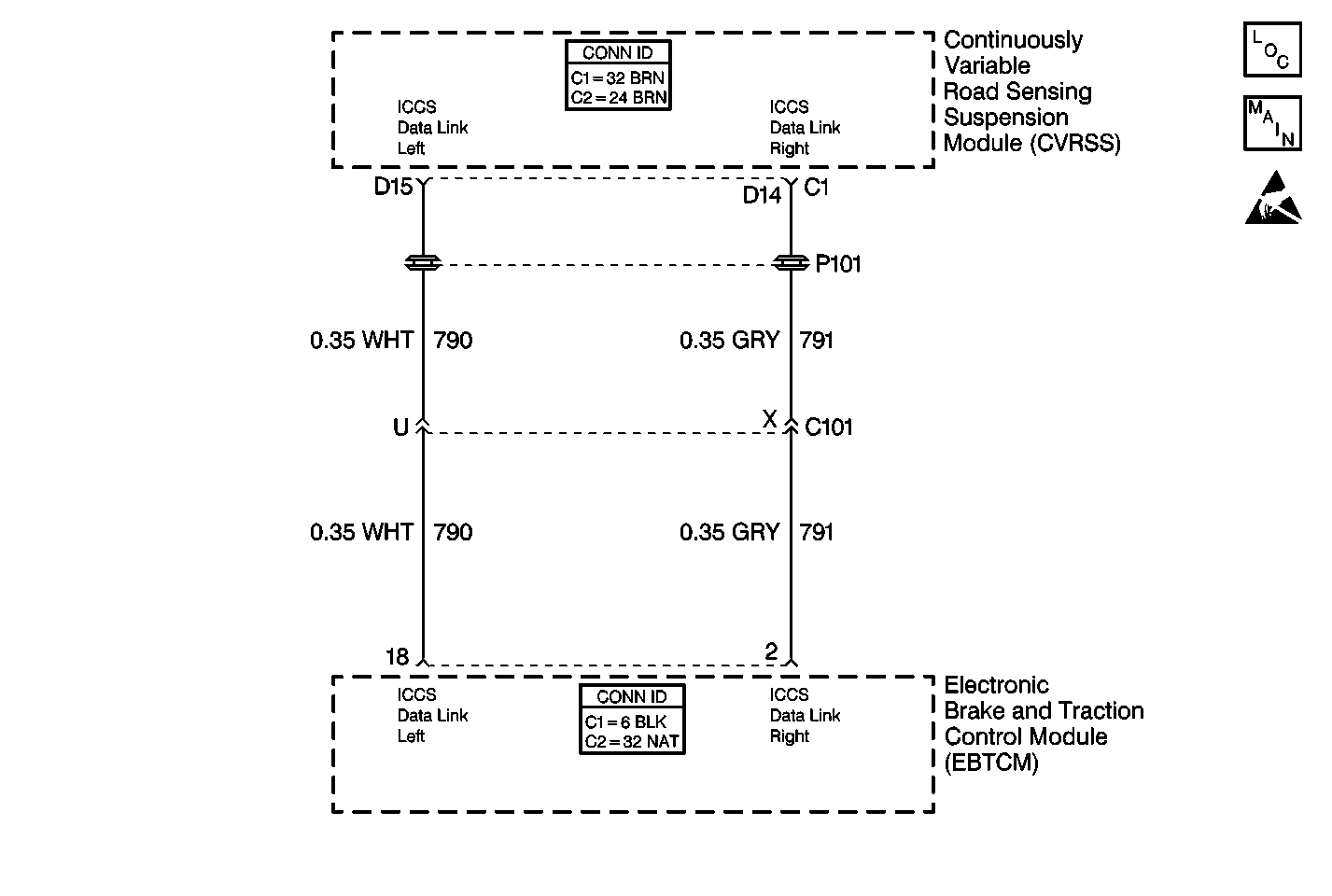
Circuit Description
The CVRSS calculates normal force and transmits a PWM signal to the EBTCM via two dedicated data lines, one right, and one left. The EBTCM supplies the pull up voltage. The EBTCM uses this information to detect rough road conditions and allows for more aggressive braking on rough surfaces.
Conditions for Setting the DTC
The EBTCM measures the PWM duty cycle sent from the CVRSS and checks to see that it is between 10% and 90%. The possible values of duty cycle are 20%, 40%, 60%, and 80%. The CVRSS sends each value twice therefore any normal force value sent to the EBTCM should match either the previous or next normal force value. If either of the above faults are present for more than 5 seconds out of any 10 second period the EBTCM will set a normal force fault.
Action Taken When the DTC Sets
| • | A malfunction DTC is stored. |
| • | The Stabilitrak® rough road performance enhancements are disabled. |
| • | ABS/TCS/Stabilitrak® remain functional. |
Conditions for Clearing the DTC
| • | The condition for DTC is no longer present and you used scan tool Clear DTCs function. |
| • | The condition for DTC is no longer present and you used the On-Board Clear DTCs function. |
| • | The EBTCM does not detect the DTC in 50 drive cycles. |
Diagnostic Aids
| • | Perform a thorough inspection of the wiring and the connectors. Failure to carefully and fully inspect wiring and connectors may result in misdiagnosis, causing part replacement with reappearance of the malfunction. |
| • | An intermittent malfunction may be caused by poor connections, broken insulation, or a wire that is broken inside the insulation. |
| • | If an intermittent malfunction exists, refer to Intermittents and Poor Connections . |
Step | Action | Value(s) | Yes | No |
|---|---|---|---|---|
1 | Was the Diagnostic System Check performed? | -- | Go to Step 2 | Go to Diagnostic System Check |
2 | Inspect ground G102 and G403 ensuring that each ground is clean and torqued to the proper specifications. Were any loose, damaged, or corroded grounds found? | -- | Go to Step 3 | Go to Step 4 |
3 | Repair the ground as necessary. Refer to Wiring Repairs in Wiring Systems. Is the repair complete? | -- | Go to Diagnostic System Check | -- |
4 |
Is the duty cycle always within the specified range? | 10-90% | Go to Step 5 | Go to Step 6 |
5 | Replace the EBTCM. Refer to Electronic Brake Control Module Replacement Is the replacement complete? | -- | Go to Diagnostic System Check | -- |
6 |
Is the voltage within the specified range? | Battery Voltage | Go to Step 7 | Go to Step 9 |
7 |
Is the voltage greater than the specified value? | 1 V | Go to Step 8 | Go to Step 11 |
8 | Repair CKT 790 for a short to voltage. Refer to Wiring Repairs in Wiring Systems. Is the repair complete? | -- | Go to Diagnostic System Check | -- |
9 |
Is the resistance equal to the specified value? | OL (infinite) | Go to Step 5 | Go to Step 10 |
10 | Repair CKT 790 for a short to ground. Refer to Wiring Repairs in Wiring Systems. Is the repair complete? | -- | Go to Diagnostic System Check | -- |
11 | Using the J 39200 DMM, measure the resistance between terminal 18 of the J 39700 and the CVRSS connector C1 terminal D15. Is the resistance less than the specified value? | 2 ohms | Go to Step 12 | Go to Step 13 |
12 | Suspect the CVRSS. Refer to Road Sensing Suspension Diagnostic System Check in Road Sensing Suspension-RSS. Is the diagnosis complete? | -- | Go to Diagnostic System Check | -- |
13 | Repair CKT 790 for an open. Refer to Wiring Repairs in Wiring Systems. Is the repair complete? | -- | Go to Diagnostic System Check | -- |
